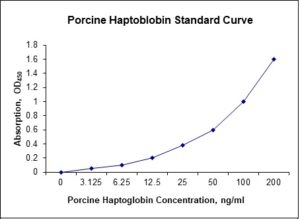Nori Porcine Haptoglobin ELISA Kit
$461.00 – $832.00
This ELISA kit is for quantification of HP in pig. This is a quick ELISA assay that reduces time to 50% compared to the conventional method, and the entire assay only takes 3 hours. This assay employs the quantitative sandwich enzyme immunoassay technique and uses biotin-streptavidin chemistry to improve the performance of the assays. An antibody specific for HP has been pre-coated onto a microplate. Standards and samples are pipetted into the wells and any HP present is bound by the immobilized antibody. After washing away any unbound substances, a detection antibody specific for HP is added to the wells. Following wash to remove any unbound antibody reagent, a detection reagent is added. After intensive wash a substrate solution is added to the wells and color develops in proportion to the amount of HP bound in the initial step. The color development is stopped, and the intensity of the color is measured.
Alternative names for haptoglobin: Haptoglobin (Hp), HP
This product is for laboratory research use only not for diagnostic and therapeutic purposes or any other purposes.
- Description
- How Elisa Works
- Product Citation (0)
- Reviews (0)
Description
Nori Porcine Haptoglobin ELISA Kit Summary
Alternative names for haptoglobin: Haptoglobin (Hp), HP
Alternative name for porcine: pig
| Assay Type | Solid Phase Sandwich ELISA |
| Format | 96-well Microplate or 96-Well Strip Microplate |
| Method of Detection | Colorimetric |
| Number of Targets Detected | 1 |
| Target Antigen Accession Number | Q8SPS7 |
| Assay Length | 3 hours |
| Quantitative/Semiquantitative | Quantitative |
| Sample Type | Plasma, Serum, Cell Culture, Urine, Cell/Tissue Lysates, Synovial Fluid, BAL, |
| Recommended Sample Dilution (Plasma/Serum) | No dilution for sample <ULOQ; sufficient dilution for samples >ULOQ |
| Sensitivity | 0.6 ng/mL |
| Detection Range | 3.125-200 ng/mL |
| Specificity | Porcine haptoglobin |
| Cross-Reactivity | < 0.5% cross-reactivity observed with available related molecules, < 50% cross-species reactivity observed with species tested. |
| Interference | No significant interference observed with available related molecules |
| Storage/Stability | 4 ºC for up to 6 months |
| Usage | For Laboratory Research Use Only. Not for diagnostic or therapeutic use. |
| Additional Notes | The kit allows for use in multiple experiments. |
Standard Curve
Kit Components
1. Pre-coated 96-well Microplate
2. Biotinylated Detection Antibody
3. Streptavidin-HRP Conjugate
4. Lyophilized Standards
5. TMB One-Step Substrate
6. Stop Solution
7. 20 x PBS
8. Assay Buffer
Other Materials Required but not Provided:
1. Microplate Reader capable of measuring absorption at 450 nm
2. Log-log graph paper or computer and software for ELISA data analysis
3. Precision pipettes (1-1000 µl)
4. Multi-channel pipettes (300 µl)
5. Distilled or deionized water
Protocol Outline
1. Prepare all reagents, samples and standards as instructed in the datasheet.
2. Add 100 µl of Standard or samples to each well and incubate 1 h at RT.
3. Add 100 µl of Working Detection Antibody to each well and incubate 1 h at RT.
4. Add 100 µl of Working Streptavidin-HRP to each well and incubate 20 min at RT.
5. Add 100 µl of Substrate to each well and incubate 5-30 min at RT.
6. Add 50 µl of Stop Solution to each well and read at 450 nm immediately.
Background:
Haptoglobin (Hp) is the protein that in humans is encoded by the HP gene.[1][2] In blood plasma, haptoglobin binds free hemoglobin (Hb) released from erythrocytes with high affinity and thereby inhibits its oxidative activity. The haptoglobin-hemoglobin complex will then be removed by the reticuloendothelial system. In clinical settings, the haptoglobin assay is used to screen for and monitor intravascular hemolytic anemia. In intravascular hemolysis, free hemoglobin will be released into circulation and hence haptoglobin will bind the hemoglobin. This causes a decline in haptoglobin levels. Conversely, in extravascular hemolysis the reticuloendothelial system, especially splenic monocytes, phagocytose the erythrocytes and hemoglobin is not released into circulation; serum haptoglobin levels are therefore normal. Haptoglobin level is used to determine whether hematology needs to be consulted for hemolytic anemia. This gene encodes a preproprotein that is processed to yield both alpha and beta chains, which subsequently combine as a tetramer to produce haptoglobin. Haptoglobin functions to bind free plasma hemoglobin, which allows degradative enzymes to gain access to the hemoglobin while at the same time preventing loss of iron through the kidneys and protecting the kidneys from damage by hemoglobin. For this reason, it is often referred to as the suicide protein. Haptoglobin is produced mostly by hepatocytes but also by other tissues. In addition, the haptoglobin gene is expressed in murine, human and Porcine adipose tissue.[3][4] Haptoglobin consists of two α- and two β-chains, connected by disulfide bridges and exists in two allelic forms in the human population, Hp1 and Hp2, the latter one having arisen due to the partial duplication of Hp1 gene. Hp has been shown to bind hemoglobin with different affinities, with Hp2-2 being the weakest binder. As haptoglobin is indeed an acute-phase protein, any inflammatory process may increase the levels of plasma haptoglobin.
References
- Dobryszycka W (1997). Eur J Clin Chem Clin Biochem35 (9): 647–54.
- Wassell J (2000). Lab.46(11–12): 547–52.
- Trayhurn P, Wood IS (2004). J. Nutr. 92 (3): 347–55.
- Saremi B, et al. (2012). Vet Immunol Immunopathol.146 (3-4): 201–11.
Be the first to review “Nori Porcine Haptoglobin ELISA Kit”
You must be logged in to post a review.





























Reviews
There are no reviews yet.